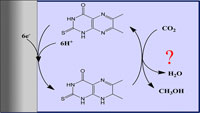Publication
790
J. Am. Chem. Soc., 138 (3), 1017-1021, 2016
DOI:10.1021/jacs.5b12138
|
|
|
|
|
|
 |
Attempts To Catalyze the Electrochemical CO2-to-Methanol Conversion by Biomimetic 2e– + 2H+ Transferring Molecules |
|
|
|
Jean-Michel Savéant and Cédric Tard
Univ Paris Diderot, Sorbonne Paris Cité, Laboratoire d’Electrochimie Moléculaire, UMR 7591 CNRS, 15 rue Jean-Antoine de Baïf, F-75205 Paris Cedex 13, France
In the context of the electrochemical and photochemical conversion of CO2 to liquid fuels, one of the most important issues of contemporary energy and environmental issues, the possibility of pushing the reduction beyond the CO and formate level and catalytically generate products such as methanol is particularly attractive. Biomimetic 2e– + 2H+ is often viewed as a potential hydride donor. This has been the object of a recent interesting attempt (J. Am. Chem. Soc. 2014, 136, 14007) in which 6,7-dimethyl-4-hydroxy-2-mercaptopteridine was reported as a catalyst of the electrochemical conversion of CO2 to methanol and formate, based on cyclic voltammetric, 13C NMR, IR, and GC analyses. After checking electrolysis at the reported potential and at a more negative potential to speed up the reaction, it appears, on 1H NMR and gas chromatographic grounds, that there is neither catalysis nor methanol and nor formate production. 1H NMR (with H2O presaturation) brings about an unambiguous answer to the eventual production of methanol and formate, much more so than 13C NMR, which can even be misleading when no internal standard is used as in the above-mentioned paper. IR analysis is even less conclusive. Use of a GC technique with sufficient sensitivity confirmed the lack of methanol formation. The direct or indirect hydride transfer electrochemical reduction of CO2 to formate and to methanol remains an open question. Original ideas and efforts such as those discussed here are certainly worth tempting. However, in view of the importance of the stakes, it appears necessary to carefully check reports in this area. |

